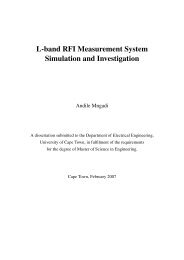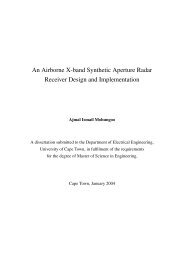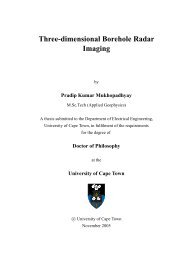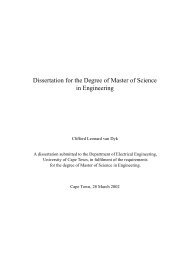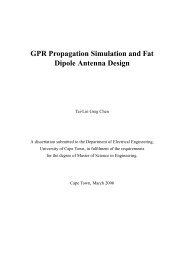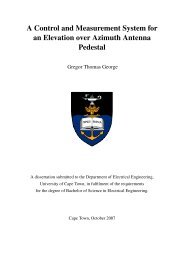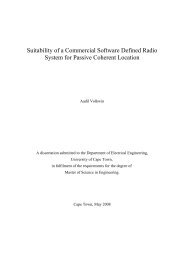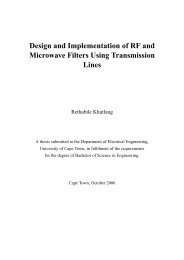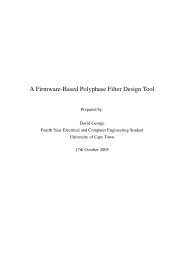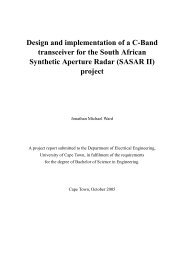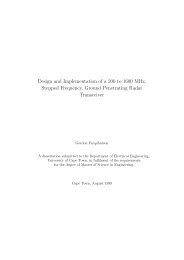Figure 13: Receive horn with the ‘dotted’ backgroundchartBFeed Angle <strong>for</strong> Equal Edge IlluminationFigure 12: Construction <strong>for</strong> Determining 3 dB PointsThis section shows how the feed pointing <strong>an</strong>gle <strong>for</strong>equal edge illumination was obtained using a graphicalmethod which will be illustrated shortly. The design isbased on finding <strong>an</strong> <strong>an</strong>gle which gives a feed taper imbal<strong>an</strong>cethat corresponds to <strong>an</strong> equal edge illumination.The difference in edge illumination at the edge <strong>of</strong> thereflector is given by [20] :∆EI = EI U − EI L [dB] (22)For a bal<strong>an</strong>ced edge illumination ∆EI = 0, there<strong>for</strong>eequation 22 c<strong>an</strong> be written as [20]:S =RθFT L + SPL U = FT L + SPL L (23)Substituting SPL into equation 22 gives( ) 0.1 × π= 20 ×180= 3.5 [cm]∆FT = FT L − FT U (24)= 40 log[cosψ L2cos ψU 2]= 4.5 [dB]Using this method the beamwidth was measured accuratelyto be 4.1 ◦ .There<strong>for</strong>e ∆FT = 4.5 dB.The <strong>an</strong>gle between the lower <strong><strong>an</strong>d</strong> the upper edge <strong>of</strong>the reflector is approximately equal to 69 ◦ .
B.1 DescriptionA Small piece <strong>of</strong> gridded paper is cut out with the samescale as in the feed pattern <strong><strong>an</strong>d</strong> with a width <strong>of</strong> 69 ◦ . Thereference points ‘O’ <strong><strong>an</strong>d</strong> ∆FT are marked as shown infigure 14. The marked piece <strong>of</strong> paper is moved on thefeed radiation pattern plot until the points ‘O’ <strong><strong>an</strong>d</strong> ∆FTfall on the feed pattern curve. Finally the value <strong>of</strong> the<strong>an</strong>gle between the pattern peak <strong><strong>an</strong>d</strong> the lower edge point∆FT, is read from the graph [20] .[4] Ch<strong>an</strong>g K. RF <strong><strong>an</strong>d</strong> Microwave Wireless Systems.John Wiley <strong><strong>an</strong>d</strong> Sons, 2000.[5] Clarke R H, Brown J. Diffraction Theory <strong><strong>an</strong>d</strong> <strong>Antenna</strong>s.John Wiley <strong><strong>an</strong>d</strong> Sons, J<strong>an</strong> 1980.[6] Elliott R S. <strong>Antenna</strong> Theory <strong><strong>an</strong>d</strong> <strong>Design</strong>. PrenticeHall, J<strong>an</strong> 1981.[7] Harris F J. On the Use <strong>of</strong> Windows <strong>for</strong> HarmonicAnalysis with the Discrete Fourier Tr<strong>an</strong>s<strong>for</strong>m.IEEE Proceedings, 66(1):51–83, J<strong>an</strong> 1978.[8] Hollis J.S. Microwave <strong>Antenna</strong> Measurements.Scientific-Atl<strong>an</strong>ta, Inc, Atl<strong>an</strong>ta Georgia, Jul 1979.[9] Holzm<strong>an</strong> L. <strong>Pillbox</strong> <strong>Antenna</strong> <strong>Design</strong> <strong>for</strong> MillimeterWave Base-station applications. IEEE <strong>Antenna</strong>s<strong><strong>an</strong>d</strong> Propagation Magazine, Vol.45(1):30–37,Feb 2003.[10] Inggs M R. SASAR II <strong>Design</strong> Document. Technicalreport, University <strong>of</strong> Cape Town - RRSG,2003.Figure 14: Feed Pointing Angle <strong>for</strong> Equal Edge IlluminationThe feed pointing <strong>an</strong>gle is then calculated by addingψ L to ψ P . For this <strong>an</strong>tenna the feed pointing <strong>an</strong>gle <strong>for</strong>equal edge illumination was calculated to be:Referencesψ E = ψ L + ψ P (25)= 11 ◦ + 38 ◦ψ E= 49 ◦[1] IEEE St<strong><strong>an</strong>d</strong>ards Online <strong>Antenna</strong>s <strong><strong>an</strong>d</strong> PropagationSt<strong><strong>an</strong>d</strong>ards.[2] Bal<strong>an</strong>is C A. <strong>Antenna</strong> Theory: Analysis <strong><strong>an</strong>d</strong> <strong>Design</strong>.John Wiley <strong><strong>an</strong>d</strong> Sons, 1997.[3] Bracewell R. The Fourier Tr<strong>an</strong>s<strong>for</strong>m <strong><strong>an</strong>d</strong> its Applications.McGraw-Hill Book Comp<strong>an</strong>y, J<strong>an</strong> 1965.[11] Inggs M R. SASAR II Subsystem Requirements.Technical report, University <strong>of</strong> Cape Town- RRSG, 2003.[12] Inggs M R. SASAR II User Requirements. Technicalreport, University <strong>of</strong> Cape Town - RRSG,2003.[13] Jasik H, Johnson R C. <strong>Antenna</strong> EngineeringH<strong><strong>an</strong>d</strong>book. McGraw-Hill Book Comp<strong>an</strong>y, 1961.[14] Jefferies D. MSc <strong>an</strong>tennas laboratory.http://www.ee.surrey.ac.uk/Personal/D.Jefferies/<strong>an</strong>tmeas.html,Mar 1998.[15] Kraus J D. <strong>Antenna</strong>s. McGraw-Hill Book Comp<strong>an</strong>y,2nd edition, 1997.[16] Orf<strong>an</strong>idis S J. Electromagnetic Waves <strong><strong>an</strong>d</strong> <strong>Antenna</strong>s.The book should be published by the end <strong>of</strong>2004, 2004.[17] Pozar D M. Microwave <strong><strong>an</strong>d</strong> RF <strong>Design</strong> <strong>of</strong> WirelessSystems. John Wiley <strong><strong>an</strong>d</strong> Sons, 2001.[18] Rudge A W, Adatia N A. Offset-Parabolic-Reflector <strong>Antenna</strong>s: A Review. In Proceedings <strong>of</strong>the IEEE, volume 66, pages 1592–1618. Institute<strong>of</strong> Electrical <strong><strong>an</strong>d</strong> Electronic Engineers, 1978.



